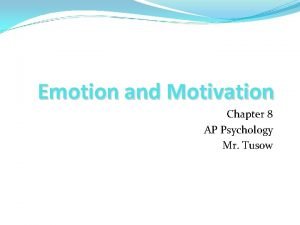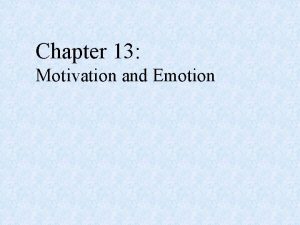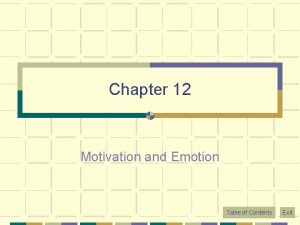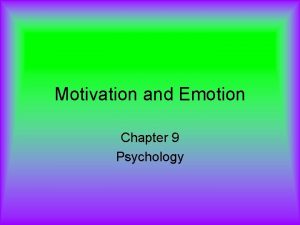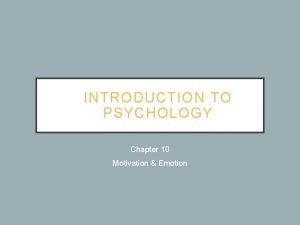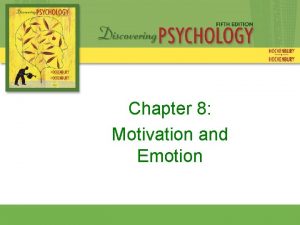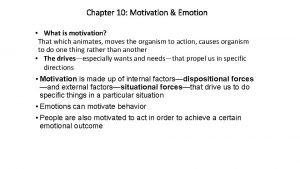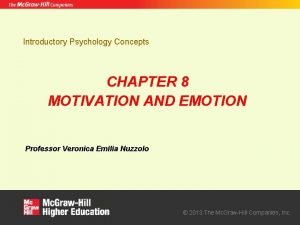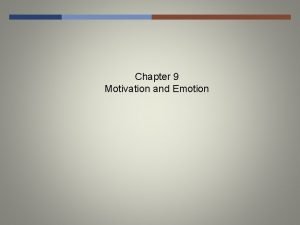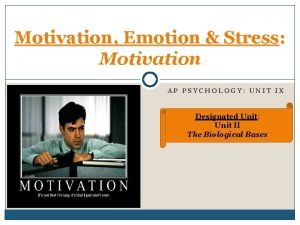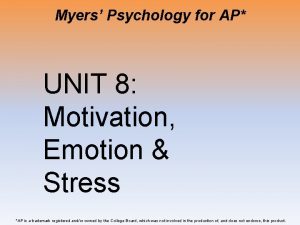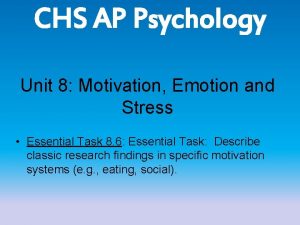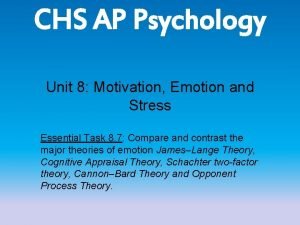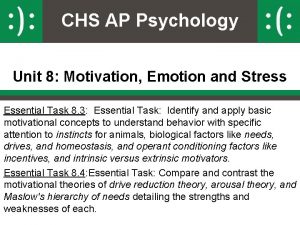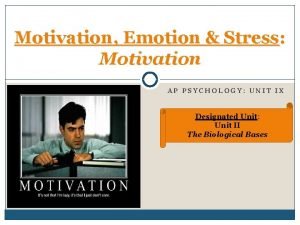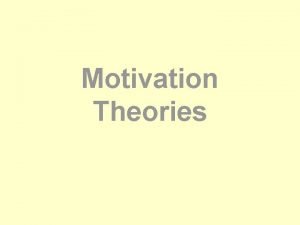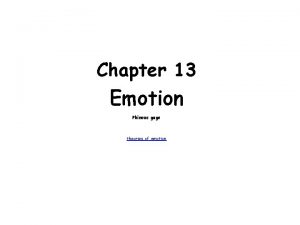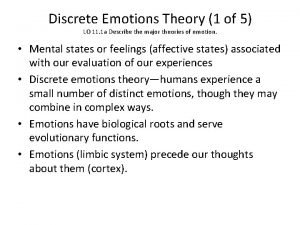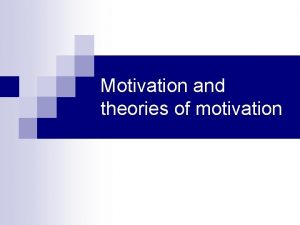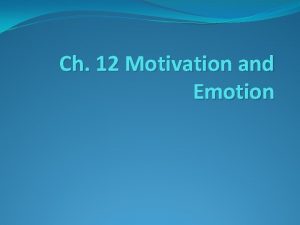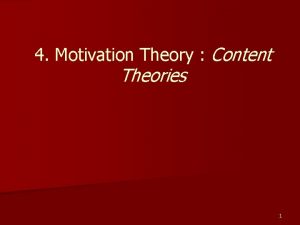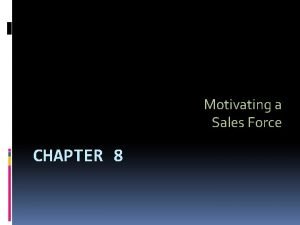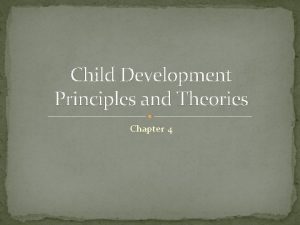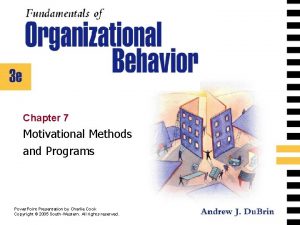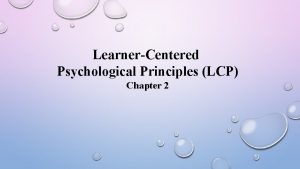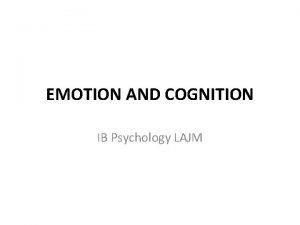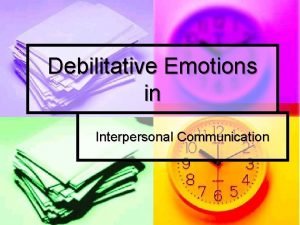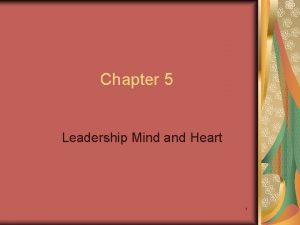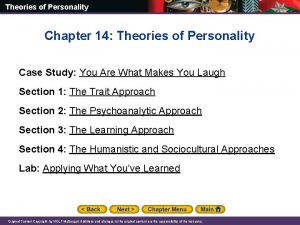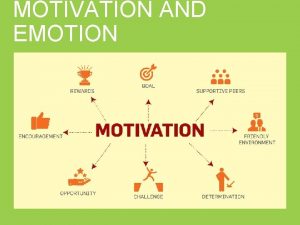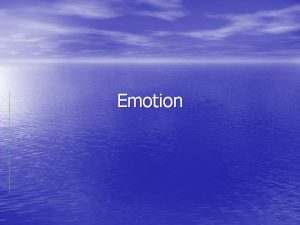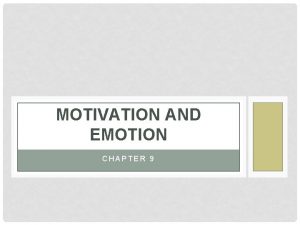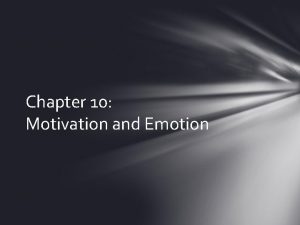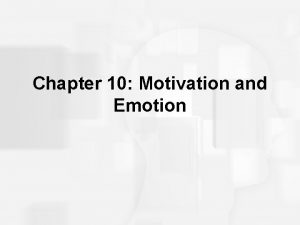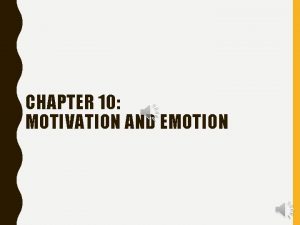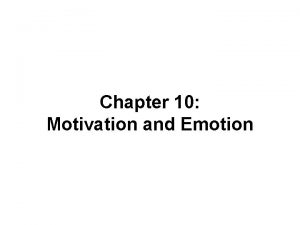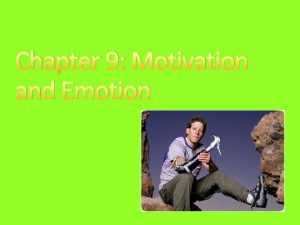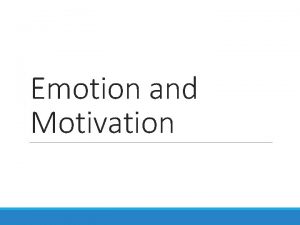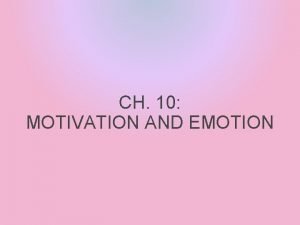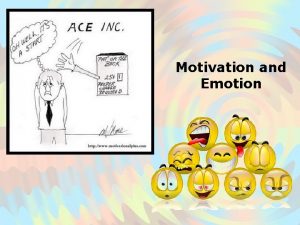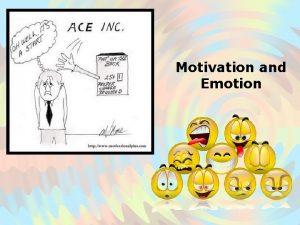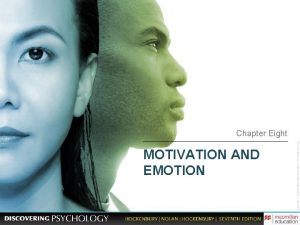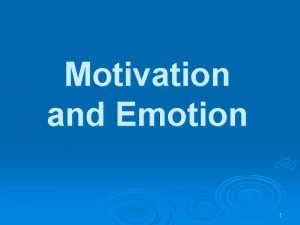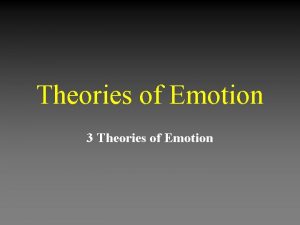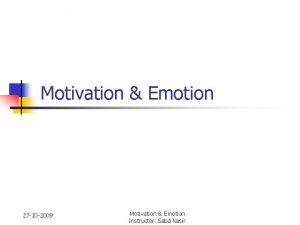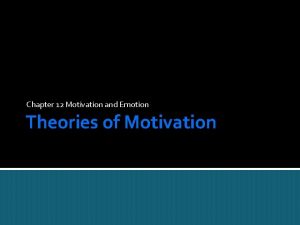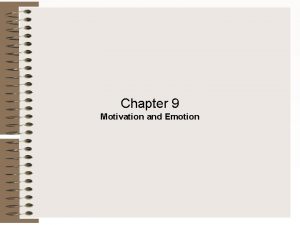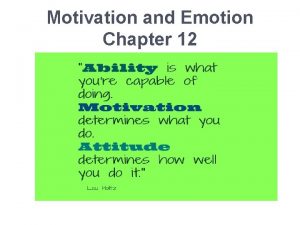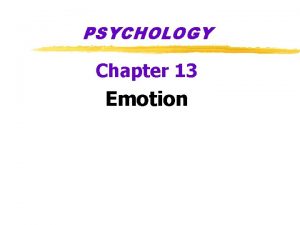CHAPTER 10 MOTIVATION AND EMOTION MOTIVATIONAL THEORIES AND





































- Slides: 37

CHAPTER 10: MOTIVATION AND EMOTION


MOTIVATIONAL THEORIES AND CONCEPTS • Motives – needs, wants, desires leading to goal-directed behavior • Drive theories – seeking homeostasis • Incentive theories – regulation by external stimuli • Evolutionary theories – maximizing reproductive success

THE MOTIVATION OF HUNGER AND EATING: BIOLOGICAL FACTORS • Brain regulation – Lateral and ventromedial hypothalamus – Ghrelin –neurotransmitter and hormone • Glucose and digestive regulation – Glucostatic theory • Hormonal regulation – Insulin and leptin

Figure 10. 3 The hypothalamus

THE MOTIVATION OF HUNGER AND EATING: ENVIRONMENTAL FACTORS • Learned preferences and habits – Exposure – When, as well as what • Food-related cues – Appearance, odor, effort required • Stress – Link between heightened arousal/negative emotion and overeating

Dog Mice Wine Fried Frog Legs Criadillas- bull testicles.

EATING AND WEIGHT: THE ROOTS OF OBESITY • Evolutionary explanations • Genetic predisposition – Body Mass Index and adoption study • The concept of set point/settling point • Dietary restraint – Mortality rates among people who are moderately overweight are not elevated in today’s population

Figure 10. 5 The heritability of weight

SEXUAL MOTIVATION AND BEHAVIOR: DETERMINING DESIRE • Hormonal regulation – Estrogens – Androgens – Testosterone • Pheromones – Synchronized menstrual cycles

SEXUAL MOTIVATION AND BEHAVIOR: DETERMINING DESIRE • Attraction to a partner • The Coolidge effect • Aphrodisiacs • Evolutionary factors

Figure 10. 8 Parental investment theory and mating preferences

Figure 10. 9 The gender gap in how much people think about sex

Figure 10. 10 The gender gap in desire for a variety of sexual partners.

Figure 10. 11 Gender and potential mates’ financial prospects

Figure 10. 12 Gender and potential mates’ physical attractiveness

THE MYSTERY OF SEXUAL ORIENTATION • Heterosexual – Bisexual – Homosexual – A continuum • Theories explaining homosexuality – Environmental – Biological – Interactionist

Figure 10. 14 Homosexuality and heterosexuality as endpoints on a continuum

Figure 10. 15 New evidence that sexual orientation exists on a continuum.

Figure 10. 16 How common is homosexuality?

Figure 10. 17 Genetics and sexual orientation

THE HUMAN SEXUAL RESPONSE • Masters and Johnson – 1966 • Stages: – Excitement – Plateau – Orgasm – Resolution

ACHIEVEMENT MOTIVATION • Achievement motive = need to excel – Work harder and more persistently – Delay gratification – Pursue competitive careers – Situational influences on achievement motives – Thematic Apperception Test (TAT)

YERKES DODSON LAW

THE ELEMENTS OF EMOTIONAL EXPERIENCE • Cognitive component – Subjective conscious experience – Positive psychology • Physiological component – Bodily (autonomic) arousal • Behavioral component – Characteristic overt expressions

OPPONENT PROCESS THEORY OF EMOTION • Have you ever felt crappy for a few days, then felt elated? This theory says feeling one way will lead you to feel the opposite. • How is this similar to the opponent process theory of color vision?

Figure 10. 22 The amygdala and fear

CULTURE AND THE ELEMENTS OF EMOTION • Cross-cultural similarities found in cognitive and physiological elements of emotional experience • Also many cultural disparities in how people perceive, think about, and express their emotions – socially engaging emotions – socially disengaging emotions

Figure 10. 23 Cross-cultural comparisons of people’s ability to recognize emotions from facial expressions

THEORIES OF EMOTION • James-Lange – Feel afraid because pulse is racing • Cannon-Bard – Thalamus sends signals simultaneously to the cortex and the autonomic nervous system

THEORIES OF EMOTION • Schacter’s Two-Factor Theory – Look to external cues to decide what to feel • Evolutionary Theories – Innate reactions with little cognitive interpretation

Figure 10. 24 Theories of emotion

Figure 10. 25 Primary emotions

HAPPINESS • Common sense notions incorrect – Income, age, parenthood, intelligence, and attractiveness largely uncorrelated – Physical health, good social relationships, religious faith, and culture modestly correlated – Love, marriage, work satisfaction, and personality strongly correlated

SUBJECTIVE WELL-BEING • Objective realities not as important as subjective feelings • When it comes to happiness everything is relative • People are surprisingly bad at predicting what will make them happy • People often adapt to their circumstances – Hedonic adaptation

Figure 10. 28 The subjective well-being of nations

Figure 10. 30 Possible causal relations among the correlates of happiness
 Cognitive appraisal psychology definition
Cognitive appraisal psychology definition Chapter 13 motivation and emotion
Chapter 13 motivation and emotion Chapter 12 motivation and emotion
Chapter 12 motivation and emotion Chapter 9 motivation and emotion quiz
Chapter 9 motivation and emotion quiz Chapter 10 motivation and emotion
Chapter 10 motivation and emotion Chapter 8 motivation and emotion
Chapter 8 motivation and emotion Chapter 10 motivation and emotion
Chapter 10 motivation and emotion Chapter 8 motivation and emotion
Chapter 8 motivation and emotion Incentive theory ap psychology
Incentive theory ap psychology Why are motives described as hypothetical states?
Why are motives described as hypothetical states? Hunger motivation ap psychology
Hunger motivation ap psychology Unit 8 myers ap psychology
Unit 8 myers ap psychology Unit 8 motivation and emotion
Unit 8 motivation and emotion Ap psychology unit 8 motivation and emotion test
Ap psychology unit 8 motivation and emotion test Instinct ap psych definition
Instinct ap psych definition Unit 8 motivation and emotion
Unit 8 motivation and emotion Ap psychology motivation and emotion activities
Ap psychology motivation and emotion activities Mayo's theory of motivation
Mayo's theory of motivation 2 factor theory of emotion
2 factor theory of emotion Discrete theory of emotion
Discrete theory of emotion Components of motivation
Components of motivation Arousal theory of motivation examples
Arousal theory of motivation examples Content theories of motivation
Content theories of motivation Incentive theory psychology definition
Incentive theory psychology definition Theories in organisational behaviour
Theories in organisational behaviour Tujuan pengajaran
Tujuan pengajaran Motivation theory of x and y
Motivation theory of x and y Sales force motivation theories
Sales force motivation theories Motivation in business management
Motivation in business management Chapter 7 motivation concepts
Chapter 7 motivation concepts Chapter 4 child development principles and theories
Chapter 4 child development principles and theories Chapter 6 - theories of international trade and investment
Chapter 6 - theories of international trade and investment Site:slidetodoc.com
Site:slidetodoc.com 14 learner centered psychological principles
14 learner centered psychological principles Teacup ib psychology
Teacup ib psychology Facilitative emotions
Facilitative emotions Leadership mind and emotion
Leadership mind and emotion Chapter 14 theories of personality worksheet answers
Chapter 14 theories of personality worksheet answers
